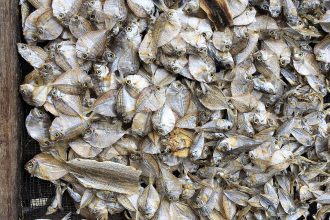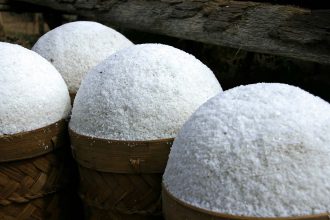
Originating from the Minangkabau people of West Sumatra, rendang has become one of Indonesia’s most celebrated and widely recognised dishes.
Rendang is created with a harmonious spice blend, including shallots, ginger, galangal, kaffir lime leaves, turmeric leaves and ground red chillies, which is then added to coconut milk and gently heated. As this spicy coconut milk mixture thickens, the primary ingredients – which can include beef shanks, shrimp, chicken, mussels, jackfruit, glutinous rice flour, even fresh edible leaves – are added and cooked through.
Minangkabau Rendang
Rendang is a way of life and an important cultural element for the Minangkabau people and for the West Sumatra area. Families proudly serve rendang as a pemanggak (important icon) and main attraction during banquets. Weighing between 250 grams and one kilogram, rendang is considered a dish superior to all other dishes and known as Samba Gadang (“enormous side dish”), during traditional Minangkabau events. It is placed at the end of the table on a long white cotton tablemat together with potato fritters, vegetables and fish dishes.
The dish is also revered because its complex preparation can unify several families in communal village kitchens.
Rendang as a Cooking Method
People often only think of rendang as a dish, but in fact it is also a cooking method. The word “rendang” has its roots in marandang, a word found in the Minangkabau language. Marandang is a cooking process, which involves constant stirring under a low heat, usually from a wood fire, to achieve a colour transformation in the food. Because continual stirring is needed for three to nine hours, the most important ingredient needed for marandang is patience.
There are three stages of the rendang process, all based on time: gulai, followed by kalio, then the final stage is rendang.
CHART
The different cooking stages produce a wide spectrum of flavours and textures. The number of possible outcomes increases exponentially when you take into account where it is cooked. Depending on where and who is cooking rendang, the taste of the final dish can vary wildly. Each area of Indonesia has its own unique take on the cooking method and final dish.
| Gulai | Kalio | Rendang | |
| Broth Colour | Yellowfish/orange | Light Brown | Brownish/red (karonggo colour) |
| Spiced Coconut Milk | Thick | Caramelised | Dry – almost gone |
| Water Content | Full | Half | None |
CONTINUE THE JOURNEY

For many Indonesians, salted fish is one of life’s simple pleasures. We are perfectly content enjoying steamed rice, salted fish and a fiery sambal (chilli relish), devouring all with our right hand. Happiness is purely simple for most Indonesians!

Singaraja totally captivates us…”
Lisa Virgiano is brimming with enthusiasm for the local produce she and the Kaum culinary collective have discovered in Bali’s oldest port.

Rice is an essential commodity in Indonesia. Nowadays, most Indonesians think of rice not only as an indispensible component to any meal, but also as a kind of “sacred” staple. But has this forever been the case? Have Indonesians always consumed rice as part of their daily diet?

Chilli relish (sambal) is an imperative Indonesian condiment, served with almost every Indonesian dish. It arouses the appetite, ignites the senses, and complements the taste.

Bali has been part of the Asian trading network since the 15th century. Traders from Java brought rice and salt which could later be exchanged for cash crops, including pepper from Sumatra, spices from the Moluccas, and cotton from Bali.



